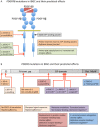PDGF, pericytes and the pathogenesis of idiopathic basal ganglia calcification (IBGC)
- PMID: 24946076
- PMCID: PMC8029277
- DOI: 10.1111/bpa.12158
PDGF, pericytes and the pathogenesis of idiopathic basal ganglia calcification (IBGC)
Abstract
Platelet-derived growth factors (PDGFs) are important mitogens for various types of mesenchymal cells, and as such, they exert critical functions during organogenesis in mammalian embryonic and early postnatal development. Increased or ectopic PDGF activity may also cause or contribute to diseases such as cancer and tissue fibrosis. Until recently, no loss-of-function (LOF) mutations in PDGF or PDGF receptor genes were reported as causally linked to a human disease. This changed in 2013 when reports appeared on presumed LOF mutations in the genes encoding PDGF-B and its receptor PDGF receptor-beta (PDGF-Rβ) in familial idiopathic basal ganglia calcification (IBGC), a brain disease characterized by anatomically localized calcifications in or near the blood microvessels. Here, we review PDGF-B and PDGF-Rβ biology with special reference to their functions in brain-blood vessel development, pericyte recruitment and the regulation of the blood-brain barrier. We also discuss various scenarios for IBGC pathogenesis suggested by observations in patients and genetically engineered animal models of the disease.
Keywords: Pericytes.
© 2014 International Society of Neuropathology.
Figures


References
Publication types
MeSH terms
Substances
Supplementary concepts
Grants and funding
LinkOut - more resources
Full Text Sources
Other Literature Sources
Medical

